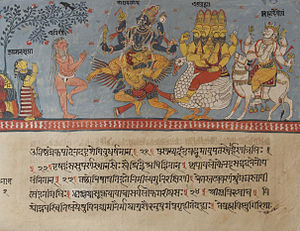Vahana
'that which carries') or vahanam (Sanskrit: वाहनम्, romanized: vāhanam) denotes the being, typically an animal or mythical entity, a particular Hindu deity is said to use as a vehicle.
The word also means 'vehicle' in Sanskrit and other Indian languages[3][4] In Hindu iconography, positive aspects of the vehicle are often emblematic of the deity that it carries.
Born to Vinata and bearing the power of Kashyapa's penance, the demigod is anguished to find that his mother is enslaved by the cruel Kadru.
The Devas and Indra, nay, even the sun and the Moon lined up against Garuḍa, but he defeated them all, and entered the particular place where the pot of nectar was kept.
Garuḍa blinded those eyes by raising a torrent of dust, pierced them in the middle with his beak and through the hole, his body reduced to such a tiny shape, went nearer to the pot.
He destroyed the wheels and the machine, and carrying the pot of nectar in his beaks rose to the sky shielding the light of the sun by his outspread wings.
After absent mindedly walking over the feet of a rishi (sage) named Vamadeva, Mushika was cursed and transformed into a mouse.
Before becoming the vehicle of Shiva, Nandi was a deity called Nandikeshvara, lord of joy and master of music and dance.
Lakshmi is, among other things, primarily the goddess of wealth, and her owl is a warning against distrust and isolationism, even selfishness.
Perhaps due to their shared geography, the Greco-Roman interpretation is paralleled in Roman Catholic iconography, in which St. Jerome, most famed for editing the New Testament, is often (though not always) depicted with an owl as a symbol of wisdom and scholarship.
In dialectic, this is countered by the retort that each totem or vahana, as an aspect of ishta-devata (or an ishta-devata or asura in its own right), has innumerable ineffable teachings, insights and spiritual wisdom; comparative analysis yields benefit, though knowledge and understanding is not served by collapsing their qualities into homogenous signification.
Durga the warrioress could not have destroyed the demon Mahishasura without the aid of her vehicle, lion, which was given by her father Himalaya, for the stated purpose.
Lakshmi, goddess of fortune, dispenses both material and spiritual riches from her mount, Uluka the owl.
However, his vehicle, Mushika the mouse, who can crawl into the smallest crevice or Akhuketana the rat, who can survive just about anywhere, can assist Ganesha to overcome the greatest obstacles.

